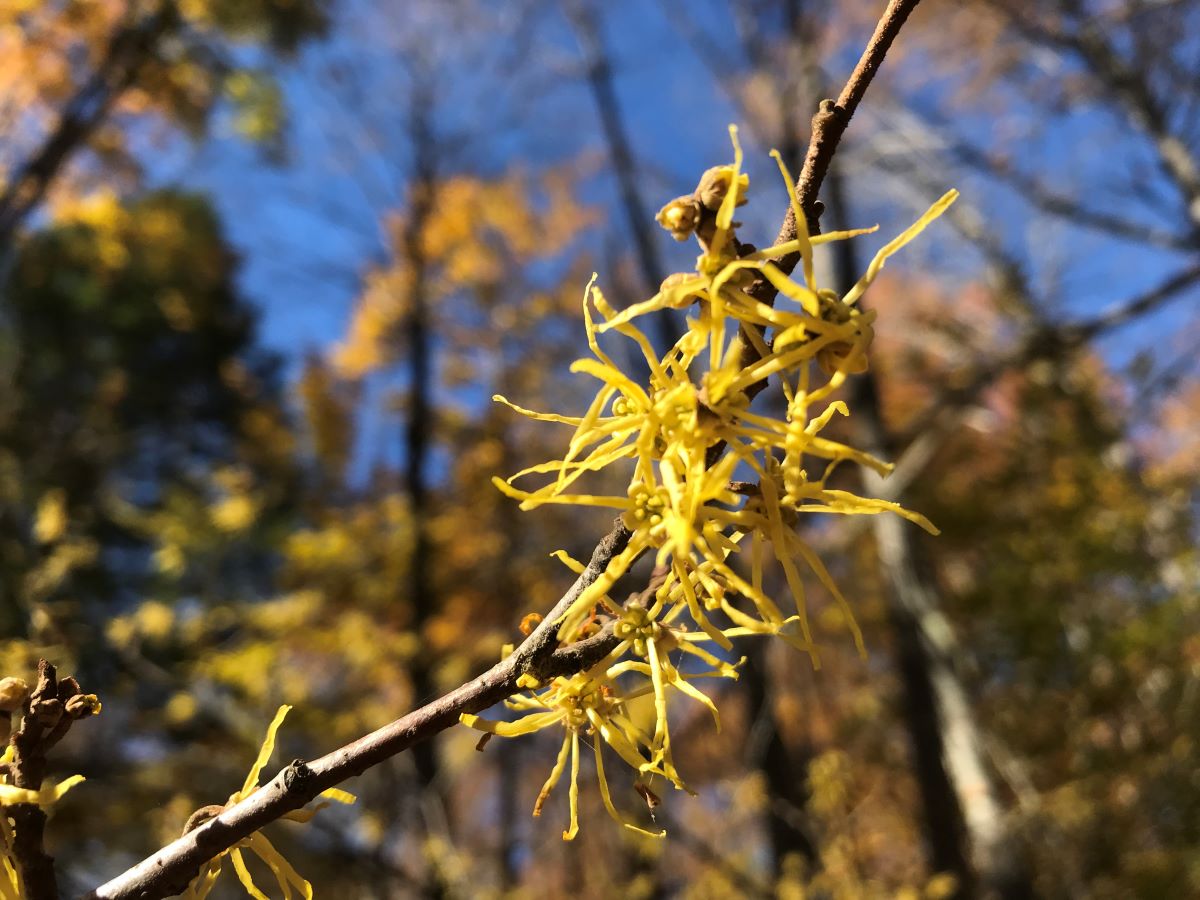Out in the Woods
- November 15th 2024
- Out in the Woods

A Witch Hazel branch, showing both blossoms and nut capsules, at the McKeon Reserve.
Photo Credit: Kevin McKeon
Witch Hazel
By Kevin McKeon, Maine Master Naturalist
The cool autumn weather beginning in October brings witch hazel into bloom. The persistent spidery yellow blossoms belong to one of those rare plants that also hold buds and fruit simultaneously. It was sometimes referred to as the “witch-of-the-woods” because it bloomed out of cycle with most other plants and shrubs.
Its flowers can persist for several months, curling up in the cold but unfurling under winter’s sun, when a rare wisp of fragrance can be enjoyed. Witch-hazels grow to be 10’-20’ tall shrubs looking like a young, multi-stemmed tree with a wide-spreading form almost as wide as it is high. They’re found from south-central Canada, down to Florida and east to Nova Scotia. It’s a fortunate treat for us trail walkers that the habitat favored by this beauty is common along trail sides, so we get to ponder these delicate bloomers quite often. Look for the small, yellow blooms among the tall bushes you pass by.
Although the tiny, seed-sized nuts are edible, witch-hazel does not refer to the nut-producing shrubs that give us delicious hazel nuts or filberts. Those two plants belong to the birch family, whereas witch hazels are in — you guessed it — the witch hazel family. The botanical name, Hamamelis virginiana, refers to the fact that the plant can have both flowers and fruits (“melon”) appear at the same time. This is called “hama”, a somewhat rare feature among plants. The virginiana relates to the Virginia settlers who used the branches dousing for water sources which is a possible reason for the “witchcraft” of dousing…thus witch hazel. Also, witch hazel’s pliant wood was similar to that of the Scottish Wych elm.
Another possibility of its name is that the essential oil extracted from its bark had “magical” or “bewitching” powers.
According to an August 1894 Good Housekeeping publication, “People do not buy it by the four or eight-ounce bottle now, but by the quart or gallon, and every medicine chest is not properly equipped unless it has a liberal supply…”
Native Americans used it as a sedative as a balm for sprains, burns, bruises, and inflammations, as a relief to the bites of insects and mixed with oil as a beauty product for the skin.
Witch hazel nut capsules hold two black seeds and turn from green to light brown, becoming woody at maturity. Since the nuts take two years to mature, a rare sight is often seen. It’s possible to see the blossom, pre-mature fruit and mature nut living next to each other. This shrub deploys an interesting seed dispersal method, probably best described by Henry David Thoreau: “I heard in the night a snapping sound, and the fall of some small body on the floor from time to time. In the morning, I found it was produced by the witch-hazel nuts on my desk springing open and casting their seeds quite across my chamber, hard and strong as these nuts were.” This is called dehiscence and happens after the seeds overwinter in their capsules, ripening in the fall. As they ripen, the capsules contract and tighten, then violently burst open, throwing their seeds up to 45 feet away, giving the shrub another name: snapping-hazel.






